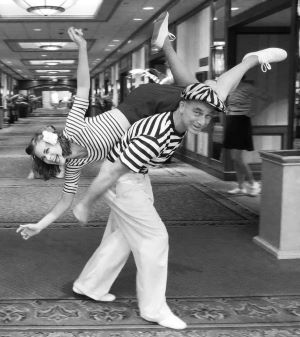Dance Styles at Dance Manhattan
Swing Lindy
Download the Study Guide
[word format]
Born in the early 30's in Harlem New York, Lindy Hop is the grandfather of all modern swing types.
Swing consists of six and eight count patterns, and consists of sub-styles ranging from Collegiate Shag, to Swing/Lindy (called East Coast Swing, by some, in its 6-count form), to Balboa, to Hollywood Style, to West Coast Swing.
Lindy Hop
Also known as "Jitterbug" or "Bop", this truly American-bred dance has been danced in New York since 1927. It has a strong Charleston influence and is danced in a circular pattern instead of a slot as in West Coast Swing. Lindy Hop curriculum includes 6 & 8 count triple, double and single rhythm footwork, 30's style Charlestons and variations and era specific jazz movements. It can be danced to all tempos of music, from big band swing to 50's rock n' roll music. At the advanced level, it can be done with aerial (overhead) steps which are choreographed and practiced.
Lindy Hop Charleston video-Paolo Lanna and the Rhythm Stompers
Smooth Swing
A style of Swing Lindy which isn't bouncy like the "Jitterbug", but is more relaxed and subtle. Smooth Swing plays with syncopated rhythms and footwork in 6 & 8 count triple and single rhythm footwork. It does not include Charlestons or break away jazz movements as in Lindy Hop. It is a style that is danced to any tempo swing music, but no hopping!
Smooth Swing Video-Carol Fraser & Andrew D'Angelo
Dean Collins Style / Hollywood style
This dance resembles the eight count patterns of Lindy Hop, but focuses more on counter balance and whip technique. It tends to resemble a rubber band kind of movement. Known to many as the "missing link" between early Lindy Hop and West Coast Swing, this style of swing was the first to form the dance slot, which was created for the purpose of filming dancers in the 1930's and 40's.
Balboa
Balboa merges the finesse and grace of ballroom dancing with the style and spirit of swing dancing. Created in the overcrowded ballrooms of 1930's California, Balboa is often danced in closed position, called "pure balboa". Even the turns and open position patterns, called "bal-swing", feature smaller, more elegant movements as compared to balboa's more famous swing cousin, Lindy Hop. This makes balboa a perfect addition to your dance repertoire for faster music, although balboa is traditionally danced at all tempos.
Balboa Competition Performance by Bal Champion, Jen Barnett
Balboa Student Performance Team -Choreographed by Carol Fraser
East Coast Swing
A style term used by some to characterize swing dancing strictly comprised of six count patterns (called simply Swing/Lindy in our curriculum). Knowledge of six count patterns is a prerequisite for all styles of swing dancing. We teach these basic, critical movements at the Basic and Advanced Basic level of our Swing/Lindy program. Social swing dancing ultimately combines these fundamental patterns with 8-count movements.
Collegiate Shag
This is an eight count type of swing executed through upward movement, almost hopping. There are versions of single time and double time Collegiate Shag.
These varieties of swing dancing, all of which stem from 6 and/or 8 count basics, can be combined while social dancing to create a very exciting dance experience.
Collegiate Shag Video-Choreographer Paolo Lanna & the Flying Camels, Summer 2017
This and future months’ Swing Lindy dance class schedule.




 Instructors
Instructors